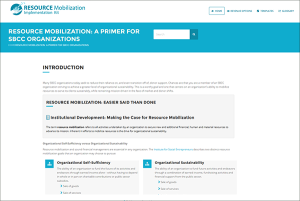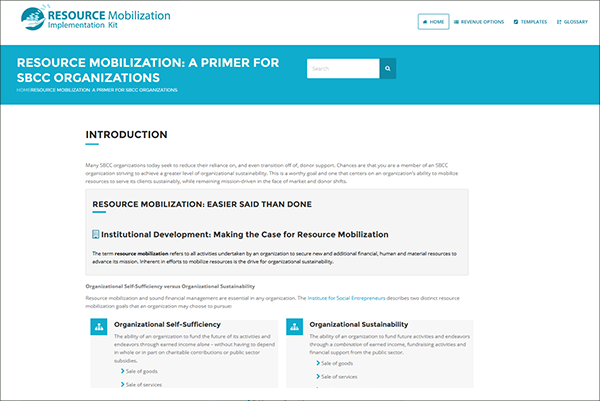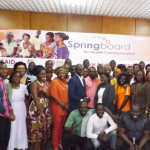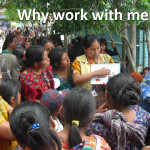The Resource Mobilization Implementation Kit (I-Kit): The Stepping Stone to Organizational Sustainability
 Many non-governmental organizations engaging in social and behavior change communication (SBCC) today seek to reduce their reliance on, and even transition off of, donor support. Chances are that you are a member of an SBCC organization striving to achieve a greater level of organizational sustainability. This is a worthy goal and one that centers on an organization’s ability to mobilize resources to serve its clients in a sustained fashion, while remaining mission-driven in the face of market and donor shifts. This I-Kit was created to guide organizations that seek to broaden their funding base to include fees from clients as well as funding from donors, corporate sponsors, public sector subsidies, charitable contributions and other funding or investment mechanisms. This will allow for a diversification of risk and not threaten the effective implementation of critical programs that improve the lives of their beneficiaries.
Many non-governmental organizations engaging in social and behavior change communication (SBCC) today seek to reduce their reliance on, and even transition off of, donor support. Chances are that you are a member of an SBCC organization striving to achieve a greater level of organizational sustainability. This is a worthy goal and one that centers on an organization’s ability to mobilize resources to serve its clients in a sustained fashion, while remaining mission-driven in the face of market and donor shifts. This I-Kit was created to guide organizations that seek to broaden their funding base to include fees from clients as well as funding from donors, corporate sponsors, public sector subsidies, charitable contributions and other funding or investment mechanisms. This will allow for a diversification of risk and not threaten the effective implementation of critical programs that improve the lives of their beneficiaries.
The Health Communication Capacity Collaborative launched a preview of the Resource Mobilization I-Kit in a three-webinar series that provided an overview of the I-Kit and included deep dives into the themes of Developing Business Plans and Writing Proposal and Grant Applications. This opportunity was used to gather data on resource mobilization in practice. Here is what was learned from responses to the polls:
- Well over half of the respondents reported that their organizations have a New Business or Resource Mobilization Unit of one or more persons;
- Nearly 80% indicated that they are responsible for managing or contributing to any resource mobilization activities within their respective organizations;
- Half of the respondents indicated that they work for organizations that generate income by offering products and/or services to clients at a fixed price;
- Half are responsible for designing and/or marketing new products and services; however, less than half of the respondents reported that their organizations conduct market research to inform the design of new products and/or services or to make improvements to those which exist;
- And, although all of the respondents reported that their organizations pre-position for proposals and submit contract and grant proposals in response to solicitations, a portion of the respondents indicated that they have no role in writing, managing or providing technical input into proposal and/or grants.
This data illuminates the emphasis being given to resource mobilization. It also highlights the importance of making sure every member of an organization can contribute in some way to mobilizing resources.
This I-Kit is designed to allow individuals, with any level of responsibility for resource mobilization, to access and apply concepts and tools that will expand their knowledge and skills in this important area, and, perhaps more importantly, enable them to position their organizations to be mission driven and market adjusted.
Specifically, this I-Kit provides individuals with the ability and tools to:
- Identify and track Proposal and Grant Opportunities
- Expand the organization’s product and service line
- Assess the risk of business development opportunities
- Conduct market research
- Create financial models to project financial return
- Formulate dynamic business development teams
- Develop a donor database
- Pitch new business opportunities to funders and investors
User Profile: Jostas Mwebembezi
Jostas Mwebembezi is the founder and executive director of the Rwenzori Center for Research and Advocacy (RCRA). RCRA is a non-profit company limited by guarantee, registered under institutions Act 2012 with charity No. 186835 to operate in Uganda. It was formed in 2010 as a CBO/182 by a group of social workers and scientists with the purpose of fostering innovations to improve lives of women and children. RCRA is also registered with the US federal government under NCAGE code: SWF69. RCRA operates in the 7 districts of Rwenzori Region in Western Uganda and endeavors to expand coverage in Uganda and extend its technology for development services to Tanzania, Rwanda, Burundi, DRC, Malawi and South Sudan.
Mwebembezi has been perhaps the most prolific user of the contents of the HC3 Resource Mobilization I-Kit. To date, he has drafted a number of business plans and concept notes, using the business planning rubric, to propose such innovations as:
- Installing satellite dedicated Internet to the health centers to track service delivery data, as well as consumer behavior in the community.
- Creating adolescent reproductive health curriculum kiosks to improve youth’s knowledge about adolescent health and further create jobs for the unemployed vulnerable youth.
- Launching a health communications radio station to accelerate strategic health communications for healthy communities.
- Employing drones as part of a sample transport network at the sub-district level to transport samples to regional labs.
Hear Jostas Mwebembezi in his own words describe his experience using the Resource Mobilization I-Kit:
Enter the world of resource mobilization by accessing the I-Kit here. Learn how to extract new business opportunities from your strategic plan and shape them into fundable products, service and programs.
Questions about the I-Kit? Please contact Eliana Monteforte or Judy Seltzer.








Leave a Reply
Want to join the discussion?Feel free to contribute!